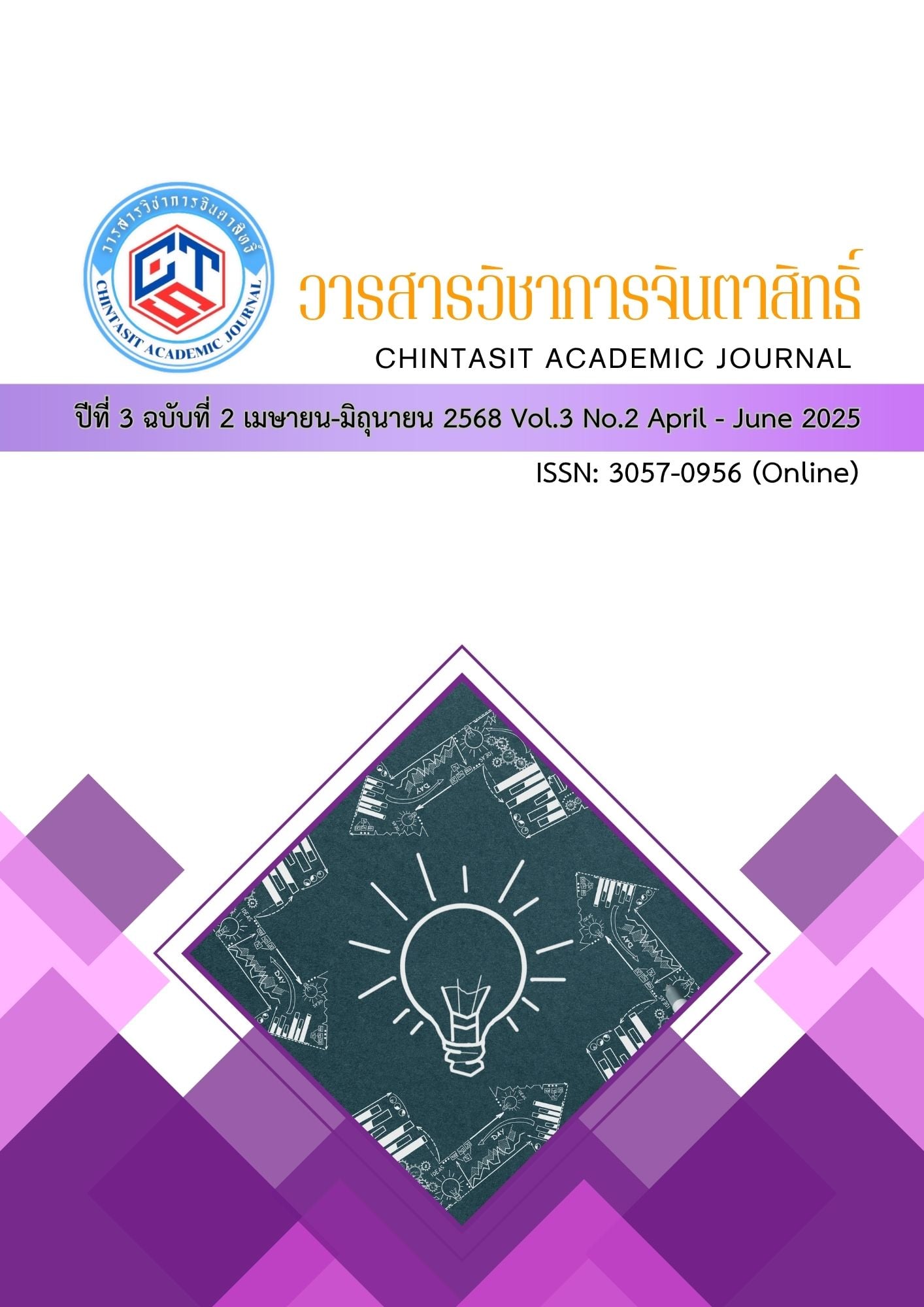การจัดการเรียนรู้แบบผสมผสานและการเรียนรู้แบบยืดหยุ่นสู่กระบวนทัศน์ใหม่ของการศึกษาไทย
Main Article Content
บทคัดย่อ
บทความวิชาการฉบับนี้มีวัตถุประสงค์เพื่อสังเคราะห์แนวคิด หลักการ และวิเคราะห์ความสัมพันธ์เชิงบูรณาการระหว่างการจัดการเรียนรู้แบบผสมผสาน (Blended Learning) และการเรียนรู้แบบยืดหยุ่น (Flexible Learning) เพื่อนำเสนอเป็นกรอบแนวคิดและกระบวนทัศน์ใหม่สำหรับการศึกษาไทยในยุคดิจิทัล การศึกษาครั้งนี้เป็นการวิจัยเอกสาร (Documentary Research) โดยทบทวนและวิเคราะห์วรรณกรรมที่เกี่ยวข้องจากผลงานของนักวิชาการทั้งในและต่างประเทศอย่างครอบคลุม ผลการสังเคราะห์พบว่า การเรียนรู้แบบยืดหยุ่น (Flexible Learning) เป็นปรัชญาการศึกษาที่กว้างกว่า มีเป้าหมายเพื่อปลดปล่อยการเรียนรู้จากข้อจำกัดด้านเวลา สถานที่ และวิธีการ โดยให้อำนาจและทางเลือกแก่ผู้เรียนในการควบคุมวิถีการเรียนรู้ของตนเอง (Pace, Place, Path) ในขณะที่การจัดการเรียนรู้แบบผสมผสาน (Blended Learning) ซึ่งเป็นการบูรณาการอย่างมีเป้าหมายระหว่างการเรียนรู้ในชั้นเรียนแบบเผชิญหน้า (Face-to-Face) และการเรียนรู้ออนไลน์ (Online Learning) ถือเป็นหนึ่งในกลยุทธ์และรูปแบบการจัดการเรียนรู้ (Modality) ที่มีประสิทธิภาพที่สุดในการทำให้ปรัชญาการเรียนรู้แบบยืดหยุ่นเกิดขึ้นได้จริง บทความนี้วิเคราะห์ความสัมพันธ์ดังกล่าวผ่านกรอบแนวคิดสำคัญ เช่น ชุมชนแห่งการสืบสอบ (Community of Inquiry - CoI) และแบบจำลอง SAMR (SAMR Model) เพื่อชี้ให้เห็นว่าการออกแบบการเรียนรู้แบบผสมผสานที่ก้าวหน้าสามารถส่งเสริมมิติทางสังคม (Social Presence) มิติทางการสอน (Teaching Presence) และมิติทางปัญญา (Cognitive Presence) ได้อย่างสมดุล และเปลี่ยนผ่านจากการใช้เทคโนโลยีเพื่อเสริมประสิทธิภาพไปสู่การพลิกโฉมการเรียนรู้ อย่างไรก็ตาม การนำไปใช้ในบริบทไทยยังคงเผชิญความท้าทายเชิงโครงสร้างและวัฒนธรรมหลายประการ อาทิ ความเหลื่อมล้ำทางดิจิทัล สมรรถนะครู หลักสูตรและการประเมินผลที่ยังไม่ยืดหยุ่น และวัฒนธรรมในสถานศึกษา ข้อเสนอแนะเชิงนโยบายและการปฏิบัติจึงมุ่งเน้นไปที่การสร้างระบบนิเวศการเรียนรู้ที่สนับสนุนอย่างรอบด้าน การพัฒนาครูสู่การเป็น "สถาปนิกการเรียนรู้" (Learning Architect) และการส่งเสริมวัฒนธรรมการเรียนรู้ตลอดชีวิตเพื่อรองรับการเปลี่ยนแปลงของโลกอนาคต
Article Details

อนุญาตภายใต้เงื่อนไข Creative Commons Attribution-NonCommercial-NoDerivatives 4.0 International License.
วารสารวิชาการจินตาสิทธิ์ อยู่ภายใต้การอนุญาต Creative Commons Attribution-NonCommercial-NoDerivatives 4.0 International (CC BY-NC-ND 4.0) เว้นแต่จะระบุไว้เป็นอย่างอื่น โปรดอ่านหน้านโยบายของเราสำหรับข้อมูลเพิ่มเติมเกี่ยวกับการเข้าถึงแบบเปิด ลิขสิทธิ์ และการอนุญาต
เอกสารอ้างอิง
ชัยยงค์ พรหมวงศ์. (2556). การทดสอบประสิทธิภาพสื่อหรือชุดการสอน. วารสารศิลปากร ศึกษาศาสตร์วิจัย, 5(1), 7-20.
ถนอมพร เลาหจรัสแสง. (2560). Designing e-Learning: หลักการออกแบบและการสร้าง e-Learning เพื่อการเรียนการสอน. ศูนย์นวัตกรรมการเรียนรู้ มหาวิทยาลัยเชียงใหม่.
ไพฑูรย์ สินลารัตน์. (2564). การศึกษาเชิงสร้างสรรค์และผลิตภาพ: กระบวนทัศน์ใหม่ในการศึกษาไทย. สำนักพิมพ์แห่งจุฬาลงกรณ์มหาวิทยาลัย.
วิจารณ์ พานิช. (2555). วิถีสร้างการเรียนรู้เพื่อศิษย์ในศตวรรษที่ 21. มูลนิธิสดศรี-สฤษดิ์วงศ์.
วิชัย วงษ์ใหญ่ และ มารุต พัฒผล. (2563). การออกแบบการเรียนรู้สู่สมรรถนะ. บัณฑิตวิทยาลัย มหาวิทยาลัยศรีนครินทรวิโรฒ.
สุรเชษฐ์ สันติมาลากุล. (2564). การจัดการเรียนการสอนแบบผสมผสานในยุคปกติใหม่. วารสารบริหารการศึกษา มหาวิทยาลัยศิลปากร, 12(1), 1-13.
Beatty, B. J. (2019). Hybrid-Flexible course design. Ed-Tech Books. https://edtechbooks.org/hyflex
Berge, Z. L., & Collins, M. P. (2000). Perceptions of barriers to teaching in distance education. The Quarterly Review of Distance Education, 1(1), 40-47.
Bergmann, J., & Sams, A. (2012). Flip your classroom: Reach every student in every class every day. International Society for Technology in Education.
Bonk, C. J., & Graham, C. R. (Eds.). (2012). The handbook of blended learning: Global perspectives, local designs. John Wiley & Sons.
Casey, D., & Wilson, P. (2005). A practical guide to providing flexible learning in further and higher education. Infolit.
Chickering, A. W., & Gamson, Z. F. (1987). Seven principles for good practice in undergraduate education. AAHE Bulletin, 39(7), 3-7.
Darling-Hammond, L. (2006). Assessing teacher education: The usefulness of multiple measures for assessing program outcomes. Journal of Teacher Education, 57(2), 120-138.
Garrison, D. R., & Vaughan, N. D. (2008). Blended learning in higher education: Framework, principles, and guidelines. John Wiley & Sons.
Garrison, D. R., Anderson, T., & Archer, W. (2000). Critical inquiry in a text-based environment: Computer conferencing in higher education. The Internet and Higher Education, 2(2-3), 87-105.
Graham, C. R., Henrie, C. R., & Gibbons, A. S. (2014). Developing models and theory for blended learning research. In Blended learning: Research perspectives (Vol. 2, pp. 13-33).
Horn, M. B., & Staker, H. (2015). Blended: Using disruptive innovation to improve schools. Jossey-Bass.
Knowles, M. S. (1975). Self-directed learning: A guide for learners and teachers. Cambridge Adult Education.
Laurillard, D. (2012). Teaching as a design science: Building pedagogical patterns for learning and technology. Routledge.
Moore, M. G. (1993). Theory of transactional distance. In D. Keegan (Ed.), Theoretical principles of distance education (pp. 22-38). Routledge.
Puentedura, R. R. (2006). Transformation, technology, and education. Hippasus.
Reimers, F. M., & Schleicher, A. (2020). A framework to guide an education response to the COVID-19 Pandemic of 2020. OECD.
Rose, D. H., & Meyer, A. (2002). Teaching every student in the digital age: Universal Design for Learning. Association for Supervision and Curriculum Development.
Ryan, R. M., & Deci, E. L. (2000). Self-determination theory and the facilitation of intrinsic motivation, social development, and well-being. American Psychologist, 55(1), 68-78.
Shurville, S., O’Grady, T., & May, H. (2008). Educational and institutional flexibility of Australian university websites. Campus-Wide Information Systems, 25(4), 271-285.
Siemens, G., & Downes, S. (2011). Connectivism and connective knowledge. Personal publication.
Vaughan, N. D., Cleveland-Innes, M., & Garrison, D. R. (2013). Teaching in blended learning environments: Creating and sustaining communities of inquiry. Athabasca University Press.


